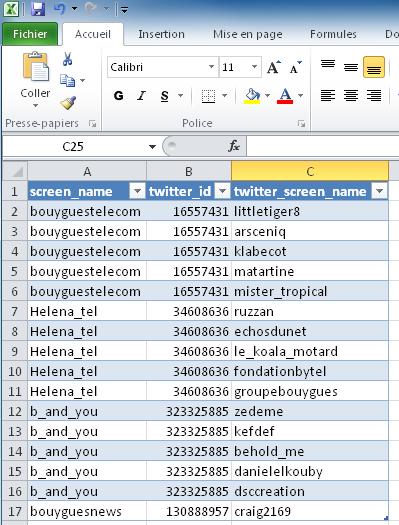 Influence is a word that keeps cropping up when online reputation and its implementation are addressed.
Influence is a word that keeps cropping up when online reputation and its implementation are addressed.
Influence is considered first and foremost as one of the analytical keys for its community ecosystem, clients or even detractors, but also as one of the weighting keys for its opinion leaders whether they’re pro or anti.
I will not return to the notion of influence. It has been defined, redefined and contra-defined whether that involves the academic definition or the online reputation point of view.
For my part, I like defining the influence of an individual or medium as its ability to influence the behaviour of those with whom he or it interacts (reading, conversations, promotion, activism, etc.) What’s more, I don’t think I’m the first to uphold this definition and even less the person who first mentioned it. Many psychologists or sociologists have drawn up and enhanced this definition by also attempting to determine the levers for exerting influence.
But here’s the problem. If this influence could be easily measured in a vacuum, if it’s conceivable to determine it for a signal that is broadcast and can be accurately and clearly isolated by the person receiving the influence message (typically an advertising campaign specific to a time t), it’s far more difficult at the level of the Web, especially if there may be multiple and varied influence messages.
This then raises the question of the influence measurement for a website, a blog, a tweet or an anonymous person on its or his community of friends.
And although I despise the notion of influence reduced to its pure quantitative analysis, i.e. an artificial figure which is derived from the crude compilation of several observable metrics (number of followers, number of videos posted, number of likes, etc.), I’m forced to admit that Klout is an operational tool that’s far from perfect, but one which has several advantages for those who wish to have a useful indicator at their disposal.
How Klout works
Let’s remembers first and foremost that Klout is a general indicator which ranges from 1 to 100. At 0, it’s no good dreaming. No buzz marketing, communications or sponsored feature agency will be contacting you. At 100, you’ll have weekends in palaces, champagne and various benefits in kind and of all types.
There are two possibilities so that Klout can calculate this indicator:
- You have a Twitter account and Klout will always be able to score this Twitter account
- You have accounts on other social media sites such as Facebook, Google+, Instagram, Flickr, etc. and Klout will be able to score these accounts if the user is registered with www.klout.com and has given details for these accounts. Ideally he will have given details of several of his social media accounts, which will enable the individual to be scored and not each of the accounts separately for the individual in question.
Consequently, the score is calculated according to the metrics that can be observed on each of these networks, which are measured, combined and regurgitated.
The operational benefits that can be gained from using Klout can be easily realised:
- The metric is the same for all social media or for any combination of social media accounts. Although it’s not perfect, it makes comparison easy and although there is a risk of adding apples to oranges to work out the captain’s age, it has the merit of being feasible. All you have to do afterwards is “rectify”, a method familiar to apprentice analysts. So Klout clearly relies on its knowledge for the weighting coefficients derived from its observations for the weight of each of the networks in the final score. In addition, it took steps this February to make an adjustment to these coefficients which is likely turn up in the next few months.
- If you make an evaluation the name of a brand or major consumer product, the proportion of tweets in the number of quotations for the above-mentioned brand is between 30 and 60 %. The fact of being able to scoring any Twitter account is an advantage for those who want to be found in the tidal wave of tweets and want to discern the difference between the nobody and THE Influencer.
- Klout is moving increasingly towards “influence gaming”. By offering an in-house Klout points system, Klout is injecting its own scoring factors endogenous to its solution. Although it must be regarded as a potential skewing of influence scoring outside Klout, this strategy includes other advantages for Klout, adding to its scoring system greater numbers of users who must register to benefit from it and who have the additional possibility of describing each of the users of Klout thematically. Klout is thus attempting to link quantitative influence analysis and influence themes via a qualitative segmentation of its users that they themselves provide. (By distributing Klout points to other Klout users or by characterising a Klout user on a on a theme area, I have more chance of gaining Klout points Klout or being classified by theme by a third party.)
Klout and APIs
As with all so-called Web 2 solutions which are riding high, Klout has developed its own APIs (Application Programming Interfaces).
It is undeniably one of the points which makes Klout a solution that enables a large-scale roll-out of measuring the influence of content producing internet users to be envisaged.
And, of course, the point of this post was to show you what it is possible to do with Klout’s APIs.
An API enables data to be sent to a third party solution and for it to be asked to process this data within its system and to send the completed results of the processing to be sent back to you.
Without going into details, an API enables a vendor such as Klout to:
- Enhance its ecosystem of solutions based on its database and its technologies by facilitating interactions with the latter (this has been the strength of Twitter for example, which has been able to speed up its development by leaving the task of developing software or Web interfaces for its infrastructure and its data to others .)
- Control who does what with its data. By opening up the APIs, solutions such as Klout or Twitter need to establish each other’s identity to be able to interact with the data. This enables them to know who’s doing what, to control quotas and incidentally to monetise them eventually.
- Standardise the way of interacting with the data. APIs are in fact always supplied with directions for use.
- Democratise the solution offered by increasing its exposure to the general public.
- Remain in control of its primary data which is no longer duplicated but called upon.
Consequently, before working with Klout’s APIs, you’ll need to apply for an identifying API key that you’ll need for all interactions with Klout’s infrastructure and, if you’re brave enough, you’ll have to study the documentation (V1 of the Klout API should be done away with in the near future, but V2 is still only in beta).
What do Klout’s APIs enable?
Klout’s APIs enable different items of information to be obtained, such as:
- An account’s score using a a name or a list of Twitter account names;
- The type of influencer that a user is (Klout defines 4 major types of influencers according to their posting activity, their retweet rate, the structure of their audience, etc.);
- The subject on which a person is a user;
- The people who influence a user or group of users;
- The people who are influenced by a user or group of users.
Klout’s APIs have some more not insignificant advantages which are using GET and providing the output data in XML format or JSON format. (For novices, XML has the advantage that it can be opened with most of the latest versions of Excel type spreadsheet programs.)
Practical exercise
Basically, this is how we could set about getting a nice Excel score file for the accounts held by Bouygues Télécom.
- Identification of the accounts via Twitter search that, for a simple “Bouygues Télécom” request, supplies us easily enough with the following accounts: bouyguestelecom, Helena_tel, b_and_you, bouyguestel, bouyguesnews
- Sending a request via Klout’s API for all these accounts, which quite simply gives us a URL for keying into a browser which looks like this: http://api.klout.com/1/klout.xml?users=bouyguestelecom%2CHelena_tel%2Cb_and_you%2Cbouyguestel%2Cbouyguesnews&key=PUT_YOUR_API_KEY_HERE
- Getting the results back in XML format which will give you the elements below for the score, for example:
<?xml version=”1.0″ encoding=”UTF-8″?>
<users>
<user>
<twitter_screen_name>bouyguestelecom</twitter_screen_name>
<kscore>57.96</kscore>
</user>
<user>
<twitter_screen_name>Helena_tel</twitter_screen_name>
<kscore>29.41</kscore>
</user>
<user>
<twitter_screen_name>b_and_you</twitter_screen_name>
<kscore>59.92</kscore>
</user>
<user>
<twitter_screen_name>bouyguesnews</twitter_screen_name>
<kscore>10.77</kscore>
</user>
</users>
which you will then be able to import very simply by saving it in Notepad with an XML extension and opening it in Excel for example. For those who are more geeky, a direct import into a MySQL or other database is also relatively straightforward via libraries such as, for example, PHP XML Library, Magic Parser in PHP and similar libraries available in the most common programming languages or provided directly by these same languages.
As the number of “scorable” accounts in a single call is relatively high (limited by the length of the GET URL), you can easily implement a simple, low-cost solution developed in-house to enhance the content collected by an online reputation system.
To do even more, it’s also possible for you to go down the networks modeling and mapping route by relying on two methods which enable you to find out the influencers and those who are influenced from a list of Twitter accounts sent to the API. A little processing loop and there you are, busy building up a structured and scored database of Twitter accounts. For producing a map of its ecosystem, for example?
Below is an example for Bouygues Télécom’s accounts using the command “influencer of”:
<?xml version=”1.0″ encoding=”UTF-8″?>
<users>
<user>
<twitter_screen_name>
<screen_name>bouyguestelecom</screen_name>
<twitter_id>16557431</twitter_id>
</twitter_screen_name>
<influencees>
<twitter_screen_name>littletiger8</twitter_screen_name>
<kscore>19.27</kscore>
<twitter_screen_name>arsceniq</twitter_screen_name>
<kscore>16.49</kscore>
<twitter_screen_name>klabecot</twitter_screen_name>
<kscore>16.05</kscore>
<twitter_screen_name>matartine</twitter_screen_name>
<kscore>15.44</kscore>
<twitter_screen_name>mister_tropical</twitter_screen_name>
<kscore>14.99</kscore>
</influencees>
</user>
<user>
<twitter_screen_name>
<screen_name>Helena_tel</screen_name>
<twitter_id>34608636</twitter_id>
</twitter_screen_name>
<influencees>
<twitter_screen_name>ruzzan</twitter_screen_name>
<kscore>41.05</kscore>
<twitter_screen_name>echosdunet</twitter_screen_name>
<kscore>37.32</kscore>
<twitter_screen_name>le_koala_motard</twitter_screen_name>
<kscore>35.09</kscore>
<twitter_screen_name>fondationbytel</twitter_screen_name>
<kscore>33.92</kscore>
<twitter_screen_name>groupebouygues</twitter_screen_name>
<kscore>29.7</kscore>
</influencees>
</user>
<user>
<twitter_screen_name>
<screen_name>b_and_you</screen_name>
<twitter_id>323325885</twitter_id>
</twitter_screen_name>
<influencees>
<twitter_screen_name>zedeme</twitter_screen_name>
<kscore>28.26</kscore>
<twitter_screen_name>kefdef</twitter_screen_name>
<kscore>20.66</kscore>
<twitter_screen_name>behold_me</twitter_screen_name>
<kscore>20.17</kscore>
<twitter_screen_name>danielelkouby</twitter_screen_name>
<kscore>18.67</kscore>
<twitter_screen_name>dsccreation</twitter_screen_name>
<kscore>18.61</kscore>
</influencees>
</user>
<user>
<twitter_screen_name>
<screen_name>bouyguesnews</screen_name>
<twitter_id>130888957</twitter_id>
</twitter_screen_name>
<influencees>
<twitter_screen_name>craig2169</twitter_screen_name>
<kscore>32.74</kscore>
</influencees>
</user>
</users>
which shows us for example from a quick glance that the BouyguesTelecom account reaches the general public, whereas the Helena_Tel account is mainly picked up by incestuous, made in Bouygues accounts and Echos du Net (and by two other accounts).
Conclusion
Klout is not a panacea for measuring influence in the smallest socio-psycho-societal and website nook and cranny, BUT Klout, and its APIs in particular, have their place in online reputation strategies and particularly in those that have to process a large number of contacts and amounts of content.
Klout is imprecise, Klout gives a general picture, Klout is simplistic, but Klout provides some answers, however imperfect they may be, whereas others only provide questions.
Moreover, as they are built – very simply – around a GET call, Klout’s APIs are easy to implement and integrate, with the results being based on two of major data exchange standards, JSON and GET.
In addition, a small detail that will interest lovers of Social Media Monitoring solutions, Radian6 has accepted Klout as its influence scoring solution and has integrated it into its Desktop interface (Radian 6 Engagement Console) and online.
Furthermore, let’s not forget that the best way of knowing your influencers is to have human knowledge, with tools such as Klout then enabling checks to be carried out beyond the bounds of its knowledge, the carrying out of consistency checks or random checks, or even discovering new potential influencers.
Going further
There are other influence indices such as:
- PeerIndex, made in Europa, likewise offering APIs
- Kred which claims transparency for its index and its way of compiling it, and which also provides APIs.
Nevertheless, as far as I’m concerned, I find that the Klout APIs offer more possibilities.





